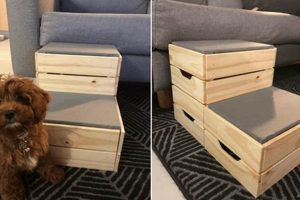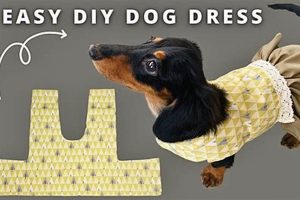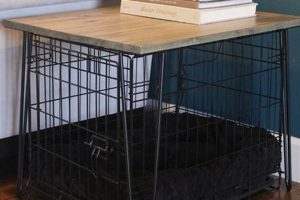The construction of a heating apparatus for canine shelters through do-it-yourself methods involves the application of various techniques and materials to provide warmth within the confined space. This undertaking typically incorporates elements of electrical wiring, insulation, and temperature regulation to create a safe and comfortable environment for the animal. Examples include modified heat lamps, repurposed seedling mats, or small, low-wattage ceramic heaters adapted for enclosed spaces.
Providing supplemental warmth to a dog’s outdoor shelter is vital for maintaining its health and well-being during periods of cold weather. Such measures can prevent hypothermia, frostbite, and other cold-related illnesses, particularly in breeds with short coats, older dogs, or puppies. Historically, owners have employed methods such as straw bedding and insulated structures; modern adaptations often integrate technology for more consistent and controllable temperature regulation.
The subsequent discussion will explore various safe and effective methodologies for constructing such heating systems, emphasizing safety precautions and considerations for different climates and dog breeds. Attention will be given to material selection, power source options, and strategies for minimizing energy consumption while maximizing thermal efficiency.
Construction Advisory
The following recommendations are intended to guide the responsible and safe implementation of supplemental heating in outdoor canine shelters. Prioritize animal safety and adhere to all relevant electrical codes.
Tip 1: Employ Ground Fault Circuit Interrupters (GFCIs). Integrate GFCIs into the electrical circuit powering any heating device. GFCIs immediately cut power in the event of a ground fault, mitigating the risk of electrical shock to the animal and owner.
Tip 2: Ensure Adequate Ventilation. Regardless of the heating method employed, provide sufficient ventilation within the structure to prevent the buildup of moisture and condensation, which can lead to respiratory issues and fungal growth.
Tip 3: Shield Heating Elements. Any exposed heating element, such as those found in heat lamps or ceramic heaters, must be shielded to prevent direct contact by the dog. Use wire mesh or similar materials to create a protective barrier.
Tip 4: Utilize Low-Wattage Heat Sources. Opt for low-wattage heating devices to minimize the risk of overheating the enclosed space. Monitor the internal temperature regularly, especially during initial use.
Tip 5: Employ Thermostatic Control. Implement a thermostat to regulate the temperature within the shelter automatically. This will prevent overheating and conserve energy by only activating the heat source when necessary.
Tip 6: Regularly Inspect Wiring and Components. Conduct routine inspections of all wiring, connections, and heating components for signs of damage or wear. Replace any compromised parts immediately.
Tip 7: Consider Alternative Heat Sources. Explore passive heating options such as insulated bedding, solar heating panels, or burying part of the structure underground before resorting to electrical devices.
These guidelines serve as a foundation for implementing supplemental heating in canine shelters. By prioritizing safety and adhering to best practices, responsible individuals can enhance the well-being of their animals during cold weather conditions.
The subsequent sections will delve into specific heating solutions, material considerations, and long-term maintenance strategies for sustained thermal regulation.
1. Safety Precautions
The integration of safety precautions constitutes a fundamental requirement in any do-it-yourself canine shelter heating endeavor. Failure to adequately address these safeguards can result in electrical hazards, burns, or thermal stress for the animal. The cause-and-effect relationship is direct: inadequate safety measures lead to increased risk of injury or death. Safety measures are thus an essential component, not merely an optional addendum, to any “diy dog house heater” project. For instance, improper wiring can cause short circuits and fires, directly endangering the animal. Similarly, exposed heating elements present a significant burn hazard.
Real-world examples underscore the critical nature of safety. Numerous incidents involving homemade heating devices have resulted in injury or death to pets due to electrical shock or overheating. Effective safety measures include the use of Ground Fault Circuit Interrupters (GFCIs) to prevent electrocution, shielding heating elements to prevent burns, and implementing thermostatic controls to regulate temperature. The practical significance of understanding these precautions lies in mitigating these risks and ensuring the well-being of the animal.
In summary, the connection between safety precautions and do-it-yourself canine shelter heating is paramount. Neglecting safety introduces unacceptable risks to the animal. By adhering to established safety standards and best practices, owners can provide a safe and comfortable environment for their pets during cold weather. Challenges remain in educating owners about potential hazards and ensuring consistent application of safety protocols. This commitment to safety aligns with the broader theme of responsible pet ownership and animal welfare.
2. Insulation Materials
Insulation materials are integral to the functionality and efficiency of any canine shelter heating solution constructed through do-it-yourself methods. The fundamental principle at play is heat retention: insulation restricts the transfer of heat from the interior of the structure to the exterior environment. This directly reduces the energy required to maintain a comfortable temperature for the animal, creating a cause-and-effect relationship where effective insulation leads to lower heating costs and a more stable internal environment. The importance of insulation is amplified in colder climates where heat loss is more pronounced. Without adequate insulation, any heating device, regardless of its power output, will struggle to maintain a suitable temperature, resulting in increased energy consumption and potential discomfort for the animal.
Examples of appropriate insulation materials include rigid foam boards (polystyrene or polyurethane), fiberglass batts, and natural options such as straw or recycled denim. Rigid foam offers high insulation value and moisture resistance, making it a practical choice for many shelters. Fiberglass batts, while cost-effective, require careful installation to avoid moisture absorption and skin irritation. Straw provides a renewable and biodegradable option but may necessitate more frequent replacement due to decomposition. The selection of insulation material should be based on factors such as climate, budget, ease of installation, and environmental impact. Consider the R-value (resistance to heat flow) of the material, with higher R-values indicating better insulation performance. It is crucial to seal all seams and gaps in the insulation to prevent air infiltration, which can significantly reduce its effectiveness.
In summary, the link between insulation materials and the overall effectiveness of canine shelter heating is undeniable. Insulation reduces heat loss, lowers energy consumption, and maintains a more stable temperature for the animal. Choosing the right insulation material and implementing proper installation techniques are essential components of a successful project. The challenge lies in balancing cost, performance, and environmental impact to select the most appropriate solution for a given set of circumstances. This careful consideration aligns with the objective of providing a safe, comfortable, and energy-efficient shelter for the animal.
3. Power Source
The power source forms a critical, enabling element of any do-it-yourself canine shelter heating system. The selection and implementation of the power source directly impact the functionality, safety, and operational cost of the entire apparatus. An inadequate or improperly installed power source presents a safety hazard, may fail to provide sufficient heat, or could result in excessive energy consumption. Therefore, the power source is not merely a supporting component but rather a fundamental prerequisite for the successful operation of a “diy dog house heater”. The cause-and-effect relationship is straightforward: the quality and suitability of the power source directly determines the effectiveness and safety of the heating system.
Several options exist for powering a canine shelter heating system, each with its own advantages and disadvantages. Standard household AC power (120V or 240V) is a common choice, offering readily available power but requiring careful adherence to electrical safety codes. Solar power presents an environmentally friendly alternative, but its reliability is dependent on weather conditions and requires an initial investment in solar panels and batteries. Battery power offers portability but necessitates regular recharging or replacement. The practical application of this understanding lies in tailoring the power source to the specific needs of the animal, the location of the shelter, and the resources available to the owner. For instance, a shelter located in a remote area with limited access to electricity might benefit from a solar power system, while a shelter near a readily available power outlet could utilize a standard AC power source. Regardless of the chosen option, proper wiring, grounding, and overload protection are essential to prevent electrical hazards.
In summary, the power source is a non-negotiable component of a do-it-yourself canine shelter heating system. Its selection and implementation must prioritize safety, efficiency, and reliability. Challenges remain in providing accessible and affordable power solutions while minimizing environmental impact. However, a thorough understanding of power source options and safety protocols enables individuals to create effective and safe heating systems for their animals. This approach aligns with the responsible stewardship of animal welfare and the utilization of appropriate technology for practical solutions.
4. Temperature Control
Temperature control is an indispensable element within any do-it-yourself canine shelter heating system. Its function extends beyond merely providing warmth; it aims to maintain a safe and comfortable thermal environment for the animal. The effectiveness of temperature control directly influences the animal’s well-being. Overheating can lead to heatstroke and dehydration, while insufficient warmth can result in hypothermia and frostbite. Thus, temperature control is not a peripheral feature, but rather a central determinant of the system’s utility. Consider a scenario where a heating element operates without any form of thermostatic regulation. The enclosed space could rapidly overheat, creating a potentially life-threatening situation for the animal. Similarly, in fluctuating weather conditions, a lack of temperature control could lead to periods of extreme cold when the heating element is insufficient to compensate. The practical significance of this understanding lies in mitigating these risks and ensuring that the heating system provides consistent and appropriate warmth.
Several methods exist for achieving temperature control in “diy dog house heater” setups. These include the use of bimetallic strip thermostats, electronic temperature controllers, and even simple on/off timers. Bimetallic strip thermostats offer a cost-effective mechanical solution, but they may lack the precision of electronic controllers. Electronic temperature controllers provide more accurate temperature readings and allow for finer adjustments, enhancing the ability to maintain a stable thermal environment. On/off timers can provide a basic level of control by limiting the operating hours of the heating element, but they do not respond to changes in ambient temperature. The selection of a temperature control method should be based on factors such as budget, desired level of precision, and the specific environmental conditions. Consider the example of a long-haired breed versus a short-haired breed; the former might require less supplemental heat and, consequently, a less precise temperature control system. Conversely, a short-haired breed exposed to harsh winter conditions would benefit from a more sophisticated and responsive system.
In summary, temperature control is a non-negotiable component of a do-it-yourself canine shelter heating system. Its implementation is crucial for safeguarding the animal’s health and well-being. Challenges remain in providing affordable and reliable temperature control solutions that are both easy to install and resistant to environmental factors. Nevertheless, a comprehensive understanding of temperature control principles and available technologies enables individuals to create effective and safe heating systems for their animals. This commitment aligns with the broader themes of responsible pet ownership, animal welfare, and the application of appropriate technology for practical solutions.
5. Weather Resistance
Weather resistance represents a critical design parameter for any do-it-yourself canine shelter heating apparatus. The exposure of outdoor structures to various environmental conditions necessitates robust construction and material selection to ensure the longevity, safety, and operational efficacy of the heating system.
- Moisture Intrusion Prevention
The ingress of moisture, whether from rain, snow, or condensation, can severely compromise electrical components within a “diy dog house heater.” Water can cause short circuits, corrosion, and ultimately, failure of the heating system. Furthermore, damp conditions can foster mold growth, posing a health risk to the animal. Encasing electrical connections in waterproof housings and employing materials resistant to water absorption (e.g., closed-cell foam insulation) mitigates this risk.
- Wind Resistance and Structural Integrity
High winds exert significant force on outdoor structures, potentially dislodging components of the heating system or causing structural damage to the shelter itself. A “diy dog house heater” must be securely mounted and integrated into a shelter designed to withstand prevailing wind conditions. Reinforcing the shelter’s frame and anchoring it to the ground are essential measures.
- Temperature Fluctuations and Material Degradation
Exposure to extreme temperature variations can lead to material degradation and mechanical stress. Plastics can become brittle and crack, while metals may corrode. Selecting materials that exhibit high thermal stability and corrosion resistance (e.g., UV-resistant plastics, galvanized steel) ensures the long-term durability of the heating system.
- Protection from Snow and Ice Accumulation
Snow and ice accumulation adds significant weight to the structure and can block ventilation openings, potentially leading to carbon monoxide buildup if combustion-based heating is employed. Designing a roof with sufficient slope to shed snow and ice is crucial. Regular removal of accumulated snow and ice is also necessary to prevent structural damage and maintain proper ventilation.
The facets of weather resistance detailed above are interconnected and mutually reinforcing. A failure to adequately address any one of these aspects can undermine the overall performance and safety of the “diy dog house heater”. Prioritizing weather resistance in the design and construction phases ensures that the heating system provides reliable and safe warmth for the animal, regardless of the prevailing environmental conditions.
6. Dog's Size
A direct correlation exists between a dog’s size and the design parameters of a do-it-yourself canine shelter heating system. The internal volume of the shelter, influenced by the animal’s dimensions, dictates the required heating capacity. An undersized shelter for a large breed will restrict movement and potentially lead to overheating due to reduced ventilation, while an oversized shelter for a small breed will result in inefficient heat retention and increased energy consumption. Therefore, the dog’s physical dimensions are not merely a contextual consideration, but a fundamental determinant of the “diy dog house heater” effectiveness.
For example, a Chihuahua requires a significantly smaller and less powerful heating element compared to a Great Dane. A small, low-wattage heating pad or strategically placed incandescent bulb might suffice for the former, while the latter necessitates a more robust heating system, potentially involving a ceramic heater with thermostatic control and increased insulation. Moreover, the size and placement of the heating element must ensure that the dog cannot directly contact it, thus preventing burns. The practicality of this consideration extends beyond mere comfort; it directly impacts the animal’s safety and physiological well-being. An inappropriately sized heating system can negate the intended benefits and, in extreme cases, pose a lethal threat.
In summary, the dog’s size forms a crucial, scaling factor in the design and implementation of a do-it-yourself heating solution for canine shelters. It influences heating capacity, shelter dimensions, and safety considerations. Challenges persist in creating adaptable and easily adjustable heating systems that can accommodate the diverse range of canine breeds and sizes. Understanding the interplay between the animal’s physical requirements and the technical parameters of the heating system is paramount to responsible and effective pet care. This emphasis on customized solutions aligns with the broader goal of providing optimal environmental conditions for the animal’s health and comfort.
7. Ventilation
Ventilation plays a crucial role in maintaining a safe and healthy environment within a canine shelter equipped with a do-it-yourself heating system. Its primary function is to regulate air quality, prevent moisture buildup, and mitigate the risks associated with inadequate air circulation. Proper ventilation is not merely an ancillary consideration; it is a fundamental requirement for ensuring the well-being of the animal.
- Prevention of Moisture Buildup
Canine respiration and perspiration contribute to increased humidity levels within an enclosed space. Without adequate ventilation, this moisture can condense on surfaces, leading to mold growth and fostering an environment conducive to bacterial proliferation. Mold and bacteria pose a direct threat to the respiratory health of the animal. Real-world examples include shelters with sealed windows and insufficient airflow exhibiting visible mold growth and a corresponding increase in respiratory infections among the dogs housed within. Ventilation, through the exchange of humid air with drier air, mitigates this risk.
- Regulation of Temperature and Heat Distribution
While the primary function of a do-it-yourself heating system is to provide warmth, ventilation plays a critical role in ensuring uniform heat distribution. Stagnant air can create localized hot spots, potentially leading to overheating, while other areas remain inadequately heated. Ventilation facilitates the circulation of warm air, preventing temperature stratification and ensuring that the entire shelter maintains a consistent and comfortable temperature. Consider a small shelter with a heat lamp concentrated in one corner; without ventilation, the immediate vicinity of the lamp will become excessively hot, while the remainder of the shelter remains cold. Proper ventilation eliminates this disparity.
- Mitigation of Carbon Monoxide Risks
If the do-it-yourself heating system employs combustion-based heating (e.g., a propane heater), ventilation becomes an absolute necessity for preventing carbon monoxide (CO) poisoning. CO is a colorless, odorless, and highly toxic gas produced by incomplete combustion. Without adequate ventilation, CO can accumulate to lethal levels within the enclosed space. While combustion-based heating systems are generally discouraged for do-it-yourself canine shelters due to this risk, if employed, CO detectors and ample ventilation are non-negotiable safety measures.
- Elimination of Odors and Improvement of Air Quality
Canine shelters, by their nature, can accumulate unpleasant odors from urine, feces, and general dog-related detritus. These odors not only create an undesirable environment but can also contribute to poor air quality, potentially irritating the animal’s respiratory system. Ventilation facilitates the removal of these odors and the introduction of fresh air, thereby improving overall air quality and contributing to a more sanitary environment. Furthermore, introducing fresh air is the easiest and most impactful way to mitigate the concentration of dander or other allergens, improving the air quality for both the dog and those who may enter the doghouse.
In summary, ventilation is inextricably linked to the safety, health, and functionality of a do-it-yourself canine shelter heating system. Its role in preventing moisture buildup, regulating temperature, mitigating carbon monoxide risks (if applicable), and improving air quality makes it an indispensable design consideration. A failure to adequately address ventilation can negate the intended benefits of the heating system and potentially endanger the animal’s well-being. Therefore, proper ventilation strategies must be integrated into any effort to provide supplemental warmth in a canine shelter.
Frequently Asked Questions
The following section addresses common inquiries regarding the implementation of do-it-yourself heating solutions for outdoor canine shelters, focusing on safety, efficacy, and practical considerations.
Question 1: What are the primary risks associated with DIY canine shelter heating systems?
The most significant risks include electrical shock, fire hazards due to faulty wiring or overheating, burns from exposed heating elements, and carbon monoxide poisoning if combustion-based heaters are used without adequate ventilation.
Question 2: How can electrical safety be ensured when building a heated dog house?
Employ Ground Fault Circuit Interrupters (GFCIs) to prevent electrocution. Use waterproof electrical enclosures and wiring designed for outdoor use. Ensure all connections are properly grounded and protected from moisture. Regularly inspect wiring for damage.
Question 3: What type of heating element is safest for use in a dog house?
Low-wattage ceramic heaters with built-in thermostats and tip-over protection are generally considered safer than heat lamps or radiant heaters, provided they are properly shielded to prevent direct contact.
Question 4: How much insulation is needed for a dog house in a cold climate?
The required insulation value depends on the severity of the climate. Generally, aim for an R-value of at least R-5 for walls and R-10 for the roof. Rigid foam insulation is recommended for its moisture resistance and high R-value per inch.
Question 5: Is it necessary to provide ventilation in a heated dog house?
Yes, ventilation is crucial to prevent moisture buildup and ensure adequate air quality. Provide openings at the top and bottom of the shelter to allow for natural convection, without creating drafts.
Question 6: How can overheating be prevented in a heated dog house?
Use a thermostat to regulate the temperature. Regularly monitor the temperature inside the shelter, especially during initial use. Provide ample ventilation. Ensure the heating element is appropriately sized for the shelter’s volume and the dog’s breed.
Prioritizing safety, appropriate material selection, and careful implementation are essential for creating a functional and secure heated environment for canine companions during cold weather conditions.
The subsequent article section will address sustainable and energy-efficient approaches to canine shelter heating solutions.
DIY Dog House Heater
This exploration of “diy dog house heater” solutions has underscored the multifaceted nature of providing supplemental warmth to outdoor canine shelters. Key aspects include the rigorous adherence to safety protocols, the strategic selection of insulation materials, the appropriate choice of power sources, the implementation of precise temperature control mechanisms, and the vital importance of weather resistance and adequate ventilation. The dog’s size and breed must also inform design decisions to ensure optimal comfort and safety.
Responsible implementation of these principles is paramount. The well-being of the animal hinges upon the diligent application of sound engineering practices and a commitment to mitigating potential hazards. Further research and development in efficient, sustainable, and safe heating solutions for canine shelters remain crucial for enhancing animal welfare during periods of inclement weather.







